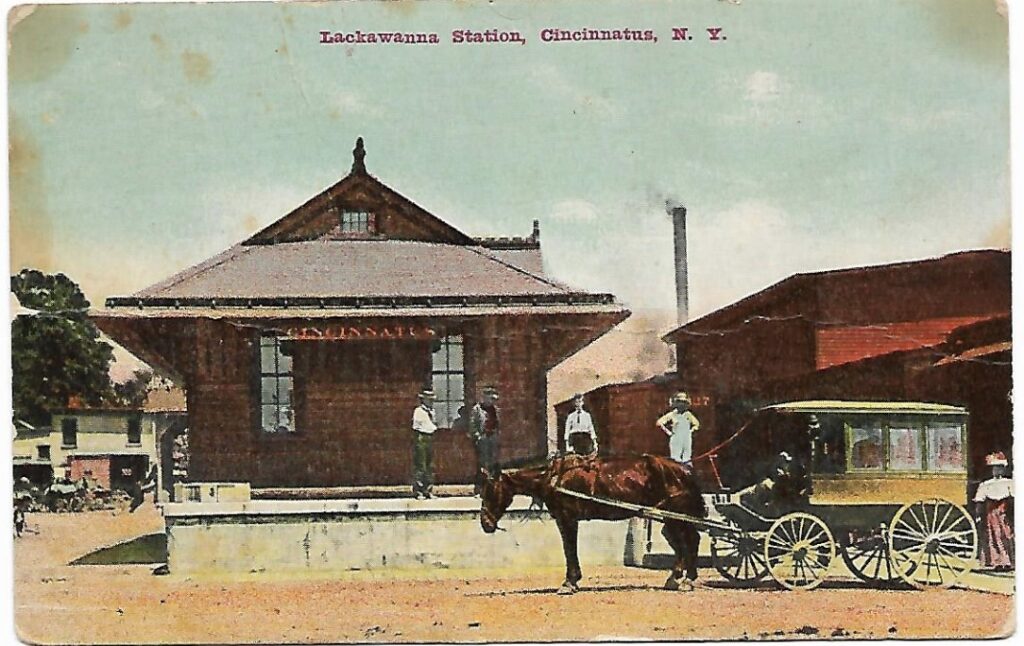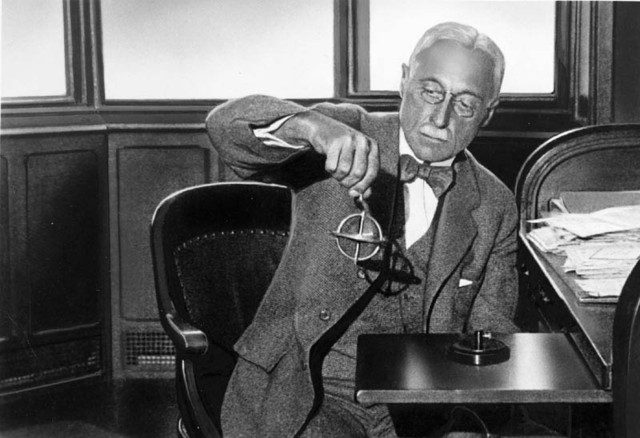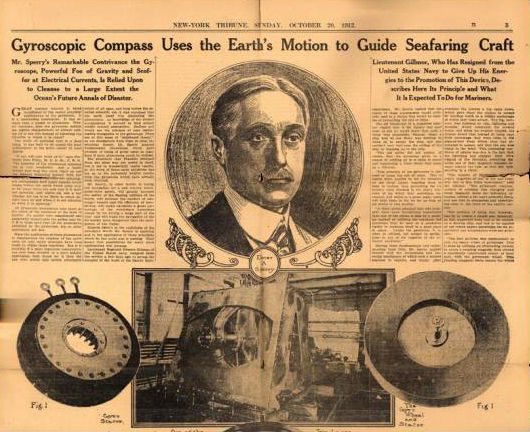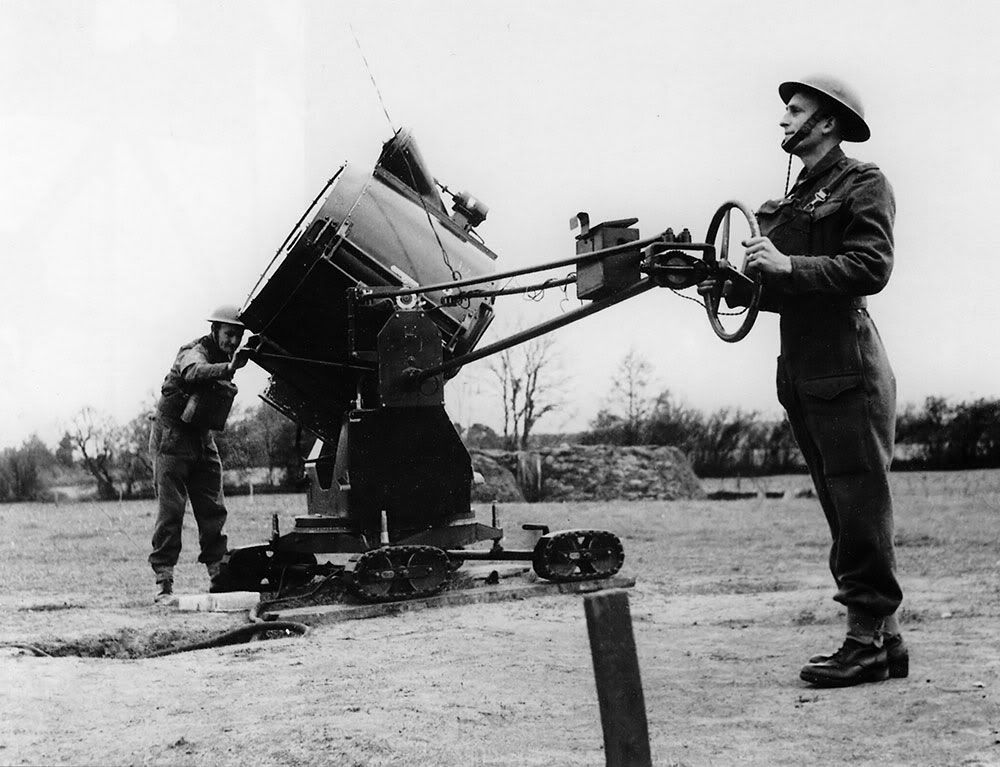An electrifying tale that will leave you spinning! Here unfolds the incredible journey of a Cortland man who would outshine the sun and out-navigate the stars.
Location #1: The Birthplace of a Great Inventor at the Intersection of Telephone Rd. Ext and Lower Cincinnatus
(42.54221308678296, -75.89580580487237)
“Elmer Sperry’s mother died at the birth of her only child,” and so begins the epic biography of Elmer Ambrose Sperry. (Biographical Memoir of Elmer Ambrose Sperry, pg. 3)
Born on the Burst family farm, nestled on Lower Cincinnatus Rd, in Cincinnatus, NY, only his mother and her parents were present to witness his birth. Mary Burst, a local schoolteacher, brought Elmer Ambrose into the world, on October 12, 1860, without her beloved husband at her side. Her husband, Stephen Sperry, was traveling for work, ignorant of the tragedy that would unfold. The following day, due to complications suffered in childbirth, Mary Burst Sperry slipped off her mortal coil. Heartbroken, Elmer’s grandparents and widowed Aunt Helen would become his primary caretakers.
Despite the dark shadows lingering over his first days, Elmer grew to be a bright and playful boy. His father, Steven, “was a hard-working man with a decided leaning toward machinery.” Though his work for the Cortland Wagon Co. regularly took him throughout the seven valleys, even as far as New York City and Chicago, his influence on his son was clear from a young age. (Cortland County Chronicles pg. 75)
“Young Sperry’s inventive bent showed itself early.” (Biographical Memoir of Elmer Ambrose Sperry, pg. 3) At the tender age of four, Elmer had built himself a toy truck from a box with working wheels and axles. By age six, he had invented a horseradish and nutmeg grater for his aunt. His childhood inventions included working miniature windmills and water wheels powered by the Tioughnioga River, which he sold as toys. Elmer’s future as an engineer, inventor, and entrepreneur were becoming evident.
Location #2: Cortland Normal School at Courthouse Park at Church Street, Cortland, NY 13045
(42.599954, -76.177865)
Eventually, Elmer left behind the quiet family farm in Cincinnatus and moved in full-time with his aunt, Helen Willet, at 124 Main Street. The bustling City of Cortland was in its bloom, filled with industry, innovation and endless engineering marvels that fascinated young Sperry.
‘’Cortland had a variety of mills and other manufacturing establishments, and young Elmer Sperry haunted them. He asked the working men intelligent questions. He stored away in his mind all the answers and very soon had a compendium of general information he became able to come up with the right answers to difficult problems all on his own- all this when the average youngster of that age was solely interested in playing baseball or stealing apples.” (Cortland County Chronicles pg. 75)
Elmer was enrolled in Cortland Normal School and quickly impressed his teachers. The school was one of the first in the United States to offer instruction in electricity. Captivated, Elmer began constructing batteries in glass jars, utilizing insulated wire and wound coils, well before the practice became the norm. Impressed, the school allowed him to install electric bells to announce class changes and assemblies.
While still in primary school, Elmer became enraptured by the Physics Department’s great instrument case, brimming with scientific tools of every imaginable kind. Dr. Samuel J. Sornberger, head of the department, saw the potential in young Sperry and gave him the run of the laboratory. ‘’He was eventually allowed to make repairs to the equipment even before he reached the academic stage when he would have been viewing the machines for the first time.” (Cortland County Chronicles pg. 80)
Having inherited his mother’s keen mind for math, Elmer was once discovered by his Mathematics Professor, Frank S. Capen, standing under a lamp post enthusiastically scribbling out solutions to the Pythagorean Proposition. When Elmer’s professor inquired as to what his pupil was doing, Elmer responded by showing him not one, but 16 original solutions!
Location #3: Rose Hall at 19 Church Street,
Cortland, NY, 13045
(42.60119842831747, -76.17745985820814)
Young Elmer Sperry was far from all work and no play. The Cortland Standard (April 4, 1832) reported that “Elmer Sperry was a fine youngster, full of daring and kept his aunt’s heart in a flutter with his many adventures and the tendency to investigate.”
Although he had little interest in sports, he invented spring bats, loaded bats and flattened bats for his friends. He developed a tight group of cohorts, including David Eugene Smith, who would later become a famous mathematician, and Charles Wickwire, of the Wickwire Empire, whom Elmer remained close with for the rest of his life. Dr. David Eugene Smith would later famously regale dinner parties with stories of growing up with a mischievous Elmer Sperry.
‘’…the famous Cortland mathematician, who died only this year (1944) used to recall a time when he and Elmer Sperry rigged up a most successful means of communication involving two tin cans and a tight string stretch between them. There too was the time that Elmer Sperry, a good Baptist, was following with a good deal of interest the erection of the steeple on the new Baptist church. The steeple was guyed to tall surrounding trees while the workmen were finishing the job. One day, he climbed to the top of the steeple, 200 feet above the ground, threw one leg over the guy, and let himself down, hand over hand on the top of a maple tree in front of the Cloye’s house on the other side of Church St. He was as cool as a cucumber about the whole matter. He knew from observation that he had a factor of safety, and then, as in later in life, he just naturally like to try new and untried things.” (Cortland County Chronicles pg. 77)
Not all of Elmer’s experiments went so swimmingly. There was a time he nearly blew up a classmate with benzine. Or the time he did blow up the neighbor’s porch and started a small fire when an experiment went awry. Perhaps that’s why he was such a devout Baptist, hoping for a little Devine protection?
Later in life, sharing his newest invention with the congregation, Elmer would light up the First Baptist Christmas tree using his electric lights. Inadvertently, Elmer had created the forerunner to the iconic American holiday tree.
While the First Baptist Church has a second life as Rose Hall and no longer wears a steeple upon its crown, we’d like to think Elmer Sperry would appreciate the stage light show. After all, he would invent them.
Location #4: Molly Reagan’s Electric Mural at the intersection of Main Street & Court Street, Cortland, NY 13045
(42.599003726318585, -76.1796620016953)
Search this utility post mural to discover Molly’s nod to Sperry’s original arc light, which stood on this corner.
“A young man named Elmer Sperry of Cortland, NY has just patented a new machine for electric lighting purposes which bids fair to out rival Edison’s. He has sold his patent to Chicago parties for $1,000,000.” (Hancock Herald, Feb. 1, 1883)
During the 1881 Annual Fireman’s Parade in downtown Cortland, what brought hundreds of people from miles around wasn’t the marching band, the fire wagons or all the gaieties, much to their chagrin. It was the invention of 19-year-old Elmer Sperry.
“…a magnificent arch has been placed over the street, corner of Main and Court Streets, with its four bases standing on each corner of the street. On top stands a figure very accurately representing a fireman in full regalia. Underneath the apex is Mr. Elmer Sperry’s electric light.” (The Democrat, Sept 2, 1881)
The parade hosted fire companies from Cortland, Homer, Auburn, Greene, Binghamton and Hornellssville for the grand procession. Yet no eye left the glowing electric lamp under which the band played. “In the evening, Sperry’s electric light shed its ray in all directions from the double arch, corner of Court and Main streets, making objects plainly discernible for several rods distant.” (The Democrat, Sept 9, 1881)
Success at hand, Elmer Sperry was quoted promising to “light up the entire northwest, in an effort to put out the stars.” (Cortland County Chronicles pg. 81) Elmer would keep that promise and would not only outshine the stars but the sun itself.
By 1914, the navy was desperate for more powerful searchlights to aid the WWI war effort. As a scientific member of the Naval Consulting Board, Elmer searched for a solution. He brilliantly altered arc lamps to burn cerium fluoride at their core rather than the previously standard carbon, allowing the lights to burn five times brighter than any other light on the planet and, in fact, even brighter than the sun. Elmer took great pride in knowing that Dr. A. Michelson, an esteemed physicist, used the new arc light to test the speed of light.
Post-war, this same spotlight would be utilized by Hollywood, whose new “talkies” required filming indoors to control ambient sound. Previously, no light had shown bright enough to allow filming out of the sun’s reach. Eventually, these same lights would be used to project outdoor films at drive-in theaters.
Even in death, Elmer Sperry’s light continued to be a beacon. “Sperry died a few weeks ago at the age of 70, but before his death he [Elmer Sperry] gave the city of Chicago the most powerful light ever built. It is known as the Lindberg Beacon, and was first used during the national air meet in August [1930]. It stands on a tower 600 feet above Lake Michigan, and throws a light more intense, per square inch of radiating surface, than that of the sun. It can be seen for 250 miles, to guide fliers to the Chicago airport. Who could want a better monument than that?” (The Friendship Register, Friendship NY, September 18, 1930)
Location #5: Cortland Train Station at 7 South Avenue,
Cortland, NY, 13045
(42.591729, -76.182124)
From when he was a boy, Elmer’s fascination with trains was undeniable. As a young boy, he turned his aunt’s hair grey by modifying a tricycle to fit the nearby railroad tracks. “…he could pedal on the railroad tracks, just head of the local freight, in exciting races to safety.” (Biographical Memoir of Elmer Ambrose Sperry, pg. 3)


The Cortland Standard (April 4, 1983) wrote of his adventures, saying, “One day he [Elmer Sperry] hid on a train at the D. L. & W. station, in a position where he could see the engine work, and his aunt worried when he did not come home for supper.”
At 14, an imaginative Elmer had drafted plans for an oscillating headlight that could illuminate the curves in the track ahead rather than pointing fixedly, potentially in the wrong direction. “The drawing was soon covered with oil smudges from the hands of the friendly locomotive engineers to whom the youngster took the idea for advice and comment.” (Cortland County Chronicles pg. 77)
In 1890, Elmer founded the Sperry Electric Railway Company, combining his two fascinations. He would develop electric trollies that, unlike the standard trolleys of the time, could climb steep terrain. Quick to recognize the opportunity in his genius, General Electric Co bought Elmer’s business in 1894, allowing Elmer to continue with his beloved experiments.
Not one to miss an opportunity for fun, Elmer modified his electric trolley engines to work in his automobile. The Waverly Electric, as it would eventually be called, was far ahead of its time with its non-reactive self-steering system, four-wheel breaks and battery life of 100 miles. Elmer even managed to convince John D. Rockefeller to indulge in his first-ever car ride- in an electric vehicle.
While Elmer Sperry’s most famous invention was undoubtedly gyroscope navigation, he never forgot his childhood love of trains. Although officially retired, Sperry sunk $100,000 of his own funds into solving a dangerous problem. Utilizing his gyroscope and magnets, Elmer engineered a car to check the safety of train tracks. At the time, train wrecks were often caused by the unpredictable collapse of rails; rails that seemed fine would suddenly and tragically crumble under the weight of a loaded train car due to nearly undetectable fissures and cracks. Elmer’s invention would, in three years’ time, detect more than one-million defective rails over two-million miles of track, potentially saving countless lives. President Hoover himself would thank Elmer Sperry for his efforts in 1929.
President Hoover wrote of him: “I have long held in high regards the achievements of the late Elmer A. Sperry, whose engineering skill and inventive genius made to the world so many valuable contributions.” (Cortland Standard, April 4, 1932)
Location #6: Suggett House Museum at 25 Homer Avenue,
Cortland, NY, 13077
(42.60269683889211, -76.184194771006)
Surprisingly, a case of sea sickness led Elmer Sperry to change the world. In 1898, after a rollicking trip on the Atlantic, Elmer developed the gyrostabilizer, devising the feat of engineering from a mere child’s toy. While the US Navy would incorporate the gyrostabilizer on some of its ships, its maintenance and expense prevented it from being used widely.


Not to be defeated, Elmer discovered yet another use for his gyroscope navigation! At the time, steel battleships struggled to use traditional magnetic compasses for navigation. On April 19, 1910, Elmer formed the Sperry Gyroscope Co. His invention would be installed on American, British, French and Italian naval ships and submarines. By the end of WWI, every merchant and Navy ship boasted a “Metal Mike.” This robot helmsman, capable of sensing and correcting tiny course deviations without suffering from fatigue or exposure, is credited with significantly altering the outcome of the Allied war efforts.
It was reported that “a ship leaving our west coast for New Zealand travels the entire distance without a human hand touching the wheel except to steer around one small intervening island in the pacific. The wheel was actually covered in cobwebs when the ship reached it’s destination.” (Cortland County Chronicles pg. 86)
Elmer Sperry became one of the most active members of the Naval Consulting Board, second only to Thomas Edison. Charles Francis Adams, Secretary of the Navy, would say of Elmer, “No one American has contributed so much to our naval technical progress.”
Location #7: Cortland Free Library at 32 Church St,
Cortland NY 13045
(42.59984102897198, -76.17829161518674)
Elmer Sperry possessed a lifelong love of reading. His mother, upon her passing, left him charts on astronomy as well as heaping stacks of books whose subjects included the sciences, algebra and geometry.
As a youth, the YMCA allowed him special access to their reading room, where he eagerly poured over endless issues of the Patten Gazette. One of his first after-school jobs was in a book bindery. One evening, after hours, Elmer secretly took apart the printing press, much to the owner’s consternation. When the proprietor discovered him there, machine in pieces, he was convinced it would never run again. However, after a thorough cleaning and oiling, the printing press ran better than ever to everyone’s relief.
As an adult, literature would become Elmer’s escape. Zula Augusta Goodman, Elmer’s wife, often indulged his love of the written word. “To him [Elmer Sperry], she often read aloud many hours a day, especially during their summers at Bellport, Long Island. This was Sperry’s greatest relaxation. He like biographies, novels and detective stories.” (Biographical Memoir of Elmer Ambrose Sperry, pg. 23)
When it was announced Cortland was to build its first public free library, Elmer was amongst the first to rally support. “It has been a keen pleasure to help in this work,’ said Mr. Sperry who in giving $10,000 was the largest single contributor towards raising the $100,000 fund.” (Syracuse Post-Standard June 24, 1927)
On a rainy June afternoon, Elmer proudly returned to his hometown to partake in ceremonies. An article from the Cortland Standard (June 1927) describes the event: “A deluge of rain cut short the ceremony of laying the cornerstone of the new Cortland Free Library yesterday afternoon, but it did not dampen the enthusiasm of those assembled for the occasion, and with the skill of an experienced mason, Elmer A. Sperry, of Brooklyn, who made the largest single contribution during the library campaign, laid the stone in place on a bed of mortar which he had prepared.”
Grainy black and white film footage bears witness that, despite the relentless rain, Elmer wielded the gold-plated trowel and smiled broadly as he proudly cemented the cornerstone of the Cortland Free Library. Sadly, this would be his final public visit to his beloved hometown.
Location #8: Bowers Science Museum at 22 Graham Avenue,
Cortland, NY, 13045
(42.59917079798458, -76.18785600857862)
While the name of the museum may have changed, the donated wire globe and gyroscope proudly remain on display.
“The Harold Tribune would say at the time of his death that he was second only to Thomas A. Edison in the history of invention.” (Cortland County Chronicles pg. 81) The world mourned the loss of Elmer, but no place more than Cortland.
“Certain it is that he [Edward Sperry] contributed much to human happiness and welfare. In personality he was so charming and spontaneously warm-hearted that he made friends everywhere. How true was this when he returned to Cortland, his boyhood home.” (Cortland Standard, April 4, 1932)
Elmer Sperry’s enduring memory is woven throughout the fabric of Cortland nearly 100 years after his death, especially at SUNY Cortland.
“I have been tremendously interested in Cortland all my life,’ he [Elmer Sperry] explained. “At the Cortland Normal School, I received the inspiration that led me on to scientific work.”
Elmer’s boyhood school, Cortland Normal School, would eventually evolve into SUNY Cortland after the original campus burned. Even still, his alma mater remained faithful to his memory.
In November 1961, Robert B. Lea, Elmer’s son-in-law and business partner, visited Cortland to honor Elmer’s memory. “The son-in-law of the greatest inventor next to Edison spoke last evening in Brockway Hall Lounge before a crowded student-townspeople gathering,” reported the Cortland Standard (Nov. 15, 1961). It would go on to say that he presented a wire globe and gyroscope to Dean Schick, SUNY Cortland Science Professor, who expected it on behalf of the college to be displayed in the Museum of Purposed Science building.
SUNY Cortland completed construction on the Sperry Center in 1967. There they dedicated a plaque in the great inventor’s honor.
The world is quite literally a brighter place for Elmer A. Sperry having been born in it. His curiosity, bravery, innovation and generosity still directly and profoundly shape our daily lives.
“Although the traits of the inventor are strong in him, Sperry has not of the eccentricities common to the species. Had not an insatiable curiosity etched a kind of quizzical alertness on his face, he would have all the surface characteristics of the conventional successful American. He is well tailored. His white hair and mustache give the required distinction; but his eyebrows are permanently raised in blended wonder and pleasure.”
Stay curious, my fellow travelers; you never know just what electrifying adventures you might discover.
Sources
1. “Light”, Old Fulton New York Post Cards (fultonhistory.com), The Friendship Register, 18 September, 1930
2. “Famed Inventor Uses Gold Trowel in Cementing Stone for New Cortland Library.” Cortland County Historical Society Archives, Syracuse Post-Standard, 24 June, 1927
3. “Elmer Ambrose Sperry.” Wikipedia, 24 July 2020, en.wikipedia.org/wiki/Elmer_Ambrose_Sperry. Accessed 3 April 2003
4. Who Made America? | Innovators | Elmer Sperry
Who Made America? | Innovators | Elmer Sperry (pbs.org) Accessed 3 April 2003
5. “C.F.D. Annual Parade.” Cortland County Historical Society Archives, The Cortland Democrat, 2 Sept. 1881.
6. “Fireman’s Parade, 1881” Cortland County Historical Society Archives, The Cortland Democrat, 9 Sept. 1881
7. Paine, Jeff. “Cortland Contrarian: DEDICATION of NEW BAPTIST CHAPEL.” Cortland Contrarian, 30 Jan. 2017, jeffpaine.blogspot.com/2017/01/dedication-of-new-baptist-chapel.html. Accessed 4 Apr. 2023.
8. Jerome Clarke Hunsaker. Biographical Memoir of Elmer Ambrose Sperry, 1860-1930. 1955.
9. Cortland County Chronicles (Vol. 3). 1979.
10. “Famous Sons of Cortland County, A Hall of Fame”,Old Fulton New York Post Cards (fultonhistory.com) Cortland Standard 4 April , 1932
11. “Sperry’s Son-In_Law Gives Gyro to the College”, Old Fulton New York Post Cards (fultonhistory.com) Cortland Standard 15 Nov., 1961
12. “Hancock Herald”, Old Fulton New York Post Cards (fultonhistory.com)
Hancock Herald 1 Feb, 1883
13. Nast, Condé. “Gadget-Maker.” The New Yorker, 12 Apr. 1930, www.newyorker.com/magazine/1930/04/19/gadget-maker. Accessed 4 Apr. 2023.
14. “Cortland Standard.” Cortland County Historical Society Archives, Cortland Standard June 1927

